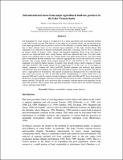| dc.contributor.author | Majaliwa, JGM | |
| dc.contributor.author | Magunda, MK | |
| dc.contributor.author | Tenywa, MM | |
| dc.contributor.author | Musitwa, F | |
| dc.date.accessioned | 2015-11-11T12:08:44Z | |
| dc.date.available | 2015-11-11T12:08:44Z | |
| dc.date.issued | 2005 | |
| dc.identifier.citation | Soil and nutrient losses from major agricultural land-use practices in the Lake Victoria basin 2Majaliwa, J.G.M, 1Magunda, M.K, 2Tenywa, M.M and 3Musitwa; F. 1 Kawanda Agricultural Research Institute (KARI), P.O. Box 7065, Kampala, Uganda 2 Makerere University, Dept. of Soil Science, P.O. Box 7062, Kampala, Uganda 3 Namulonge Agricultural and Animal Production Institute (NAARI) P.O. Box 7084, Kampala, Uganda | en_US |
| dc.identifier.uri | http://hdl.handle.net/11671/801 | |
| dc.description.abstract | Soil degradation by water erosion is recognized to be a major agricultural and environmental problem
in the Lake Victoria crescent. The objective of this study was to quantify runoff, soil and nutrient losses
from major agricultural land use practices and assess the efficiency of contour bunds in controlling the
tide of those nutrient losses in two selected micro-catchments of the Lake Victoria Basin. The
experiment was conducted on thirteen-instrumented runoff plots, measuring 15m by 10 m, established
on farmer’s fields on banana, coffee, annuals and degraded rangelands. Each of the four land-use
practices was replicated three times, except banana, which was replicated four times. Two plots under
banana were mulched and two were not. Contour bunds were hand-constructed two years after runoff
plots establishment. Eroded sediments were collected, aggregated per season and analysed for selected
nutrients. The average annual runoff ranged between 315.47 and 2438.92 m3 ha-1 yr-1. Degraded
rangelands lost relatively higher amounts of rainfall water through surface runoff compared to banana
and coffee (p=0.022). The average annual soil loss ranged from 27.7 to 86.7 t ha-1 yr-1. It was higher on
annuals compared to banana and coffee (p=0.038). Eroded sediments had relatively high nutrient
concentrations than the remaining soils, and varied with land-use and /or seasons (p<0.05), and did not
show a single pattern for all nutrients. The amount of nutrient loss through erosion was relatively high,
and varied with seasons for N,P, K and OM (p<0.05). Establishment of contour bunds led to an
increased OM and Ca and Na content in eroded sediments, while total OM and TN losses decreased for
all practices except rangelands where they increased. TNa increased on coffee, rangelands and mulched
banana (p<0.05). TP and TK losses decreased only on annuals, mulched banana and rangelands for the
short rains (p<0.05). These exports from agricultural land play a major role in the nutrient enrichment
of rivers and open water bodies. | en_US |
| dc.language.iso | en | en_US |
| dc.publisher | Lake Victoria Environmental Management Project (LVEMP) | en_US |
| dc.subject | Pollution | en_US |
| dc.subject | Sustainability | en_US |
| dc.subject | Farming system | en_US |
| dc.subject | Land-use | en_US |
| dc.title | Soil and nutrient losses from major agricultural land-use practices in the Lake Victoria basin | en_US |
| dc.type | Article | en_US |

